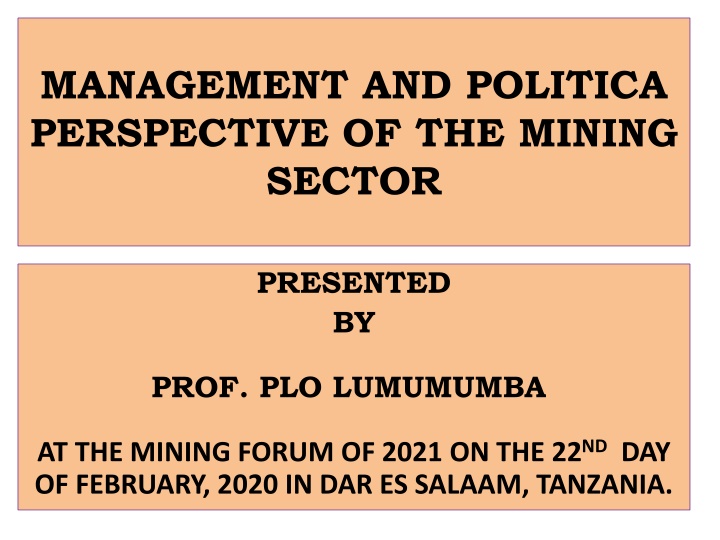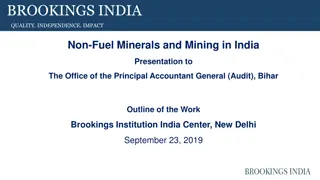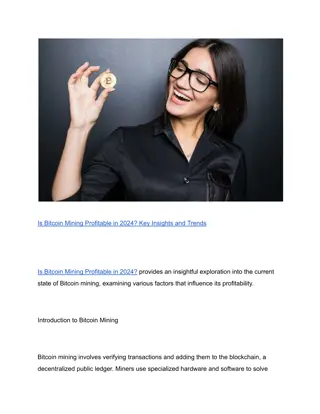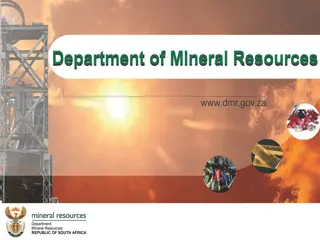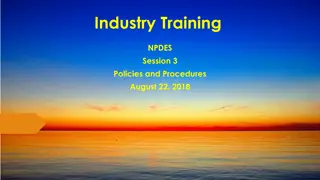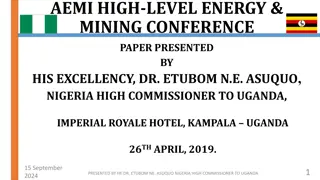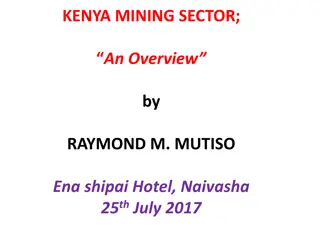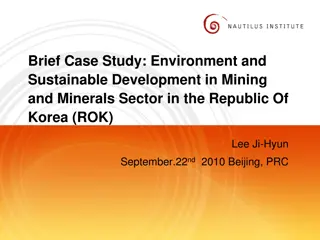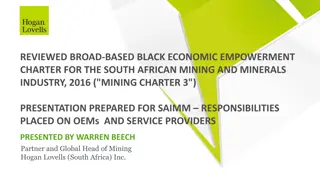Perspectives on Mining Sector Management and Policy in Africa
The presentation by Prof. Plo Lumumba at the 2021 Mining Forum in Tanzania highlighted the potential of the mining sector to drive economic transformation in Africa. The continent, rich in mineral deposits, has the opportunity to shift towards a competitive upper-middle-income status by 2040. However, the key lies in translating mining growth into inclusive and sustainable socio-economic development. The importance of a robust legal framework and policy implementation for the benefit of local communities was emphasized, along with strategies to promote local development and partnership in the mining sector.
Download Presentation

Please find below an Image/Link to download the presentation.
The content on the website is provided AS IS for your information and personal use only. It may not be sold, licensed, or shared on other websites without obtaining consent from the author.If you encounter any issues during the download, it is possible that the publisher has removed the file from their server.
You are allowed to download the files provided on this website for personal or commercial use, subject to the condition that they are used lawfully. All files are the property of their respective owners.
The content on the website is provided AS IS for your information and personal use only. It may not be sold, licensed, or shared on other websites without obtaining consent from the author.
E N D
Presentation Transcript
MANAGEMENT AND POLITICA PERSPECTIVE OF THE MINING SECTOR PRESENTED BY PROF. PLO LUMUMUMBA AT THE MINING FORUM OF 2021 ON THE 22NDDAY OF FEBRUARY, 2020 IN DAR ES SALAAM, TANZANIA.
THE MINING IN AFRICA The African continent is endowed with vast mineral deposits Mining has the potential to transform the African economy, moving Africa away from a predominantly low-income to a competitive upper-middle-income by 2040 Looking at successful resource-based development strategies elsewhere, it is clear that mineral resources can catalyze broad-based growth and development provided opportunities to deepen the resources sector, through the optimization of linkages into the domestic economy
MINING IN TANZANIA Tanzania includes metals (gold, iron ore, nickel, copper, cobalt, silver), industrial minerals (diamond, tanzanite, ruby, garnet, limestone, soda ash, gypsum, salt, phosphate, gravel, sand, dimension stones and lately graphite), and fuel minerals The challenge has been translating growth in extraction activities into inclusive and sustainable socio-economic development and transformation. Having a good policy and legal framework is nothing if it is not implemented to the benefit of local communities and the entire nation
LEGAL FRAMEWORK AND MINERAL POLICY Though repealed, the mineral sector policy and legal regime had some good provisions which included Stimulating exploration and mining development; Ensuring that mining wealth supports sustainable economic and social development; Minimizing or eliminating the adverse social and environmental impacts of mining; and Promoting and facilitating mineral and mineral-based products marketing arrangements
CONT. Strategies mentioned in the policy included: Encouraging and motivating foreign investors in mining to train Tanzanians in different skills; Encouraging and facilitating training in disciplines necessary for mineral sector s development; Requiring large scale mining companies to undertake social impact analyses on the communities and project areas and explicitly incorporate results in the project viability and draw up programmers for addressing negative impacts; Establishing a framework for timely promotion of good relations with the population of mining localities; Encouraging mining companies to contribute to local economic development by using local inputs whenever this is economically viable; Facilitating the establishment of strategic partnerships between mining companies and the local communities
CONT Meanwhile, oil production cannot resume until Juba meets some stringent conditions set by its neighbour. Khartoum had not been keen on implementing the agreements and issues surrounding the disputed oil rich Abyei region, while the government in Juba had made it clear that dialogue was the only means of resolving these issues. Besides the Abyei issues, other areas of contention are oil flow, border demarcation and a 14km demilitarized zone, which are part of a September 2012 co-operation agreement.
MINERALS IN TANZANIA Major Minerals available in Tanzania include: Iron Ore Gold Gemstone Diamonds Uranium Coal Gas
DRC The Democratic Republic of Congo (DRC) is rich in minerals such as colt an, tantalum, tin and gold. All are coveted for their widespread use in modern technologies, like semiconductors for cars and mobile phones. Sadly, child workers dig for minerals such as colt, a key component in mobile phones. The billions of pounds those minerals have generated have brought nothing but misery and death to the very people who live on top of them, while enriching a microscopic elite in the Congo and their foreign backers, and underpinning technological revolution in the developed world. DRC has been making efforts to improve its mining sector and promote the international framework for conflict-free mineral sourcing. Despite these efforts, Global Witness has documented illegal involvement of members of the Congolese army in the trade
NAMIBIA Namibia s economy heavily relies on its mining industry and its mineral resources include diamond, silver, tungsten, lead, zinc, tin, uranium, and copper. Nearly 25% of the country s income is contributed by this sector Namibia produces approximately 2% of gem-quality diamonds globally Namibia s gold production has increased to 6410 kg in 2016 from 2,057 kg in 2009 The government of Namibia, with its free-market policy, is keen on promoting the mining industry as a private sector. through policies that promote environment and economy friendly mining to stimulate and sustain economic growth.
ZAMBIA Zambia s natural resources include uranium, silver, cobalt, copper, coal, lead, silver, zinc, emeralds and gold. Zambia is also a chief global producer of semiprecious gemstones and cobalt. Zambia experienced a decline in its economy between the 1980s and 1990s due to prolonged drought, declining copper prices and economic mismanagement. Privatization of government-owned mines has led to an increase in copper mining output and uplifted Zambia s economic status in the 1990s It is a globally recognized producer of cobalt and copper. The country is globally ranked as the second largest producer of cobalt and the seventh largest producer of copper. Oil imports were estimated to reach $618 million in 2010. The mineral industry is expected to become more stable in the coming years and recover from the global economic crisis that hit the country in late 2008 and early 2009. The future of the mining industry in Zambia will thus largely depend on upgrading its copper mining operations by foreign companies and the attainment of the proposed production levels
NIGERIA Nigeria among other resources, has; Iron Ore Lead/Zinc Bentonite and Baryte Gold Bitumen Coal Gemstones Kaolin Talc Gypsum
MALAWI Malawi has abundant natural resources including limestone, and unexploited deposits such as uranium, coal, and bauxite. Malawi produces cement, coal, crushed stone, dolomite, kaolin, lime, limestone, and sulfuric acid mainly for domestic consumption. As of 2010 Uranium increased by 587% Sulfuric acid increased by 493% Ornamental stone increased by 80% Coal increased by 34% Limestone for use in cement industry increased by 22%.
CONT To further boost investments, the government will need to resolve issues such as unreliable power sources, poor telecommunications infrastructure, and water scarcity. The delay in sorting these issues brought down the investment by 23% in 2009 and this situation continued in 2010 as well. Thanks to the efforts by the government to promote the mineral industry, the mining sector of Malawi can hope for a bright future.
SOUTH SUDAN South Sudan is lining up huge projects in agriculture and mining to diversify its economy as oil exports, which are dependent on bilateral relations with Khartoum are proving unreliable. Juba is eyeing its vast and virgin agricultural lands plus unexplored deposits of gold, uranium and copper to boost its economy in coming years. The decision to diversify the economy has been prompted by the realization that Juba has 98 per cent of its budget dependent on oil. Juba, which uses the North s pipelines to transport oil, was forced to stop production recently due to disputes with Khartoum, a move that hurt virtually all sectors of the former s economy.
CONT In the book Making Africa Work , Greg Mills Jeffrey acknowledges the immense mineral wealth in the continent and prescribe the following five steps for success. Improve policy and investor certainty. Stable, efficient and transparent regulatory and administrative processes are vital investment determinants for mining companies. Develop a compelling, forward-looking realistic narrative with the mining sector about the role it will play in national development, and stick to it. Further beneficiation is dependent on cheap electricity and domestic manufacturing opportunities. Appreciate the logistics systems needed for investment in bulk minerals (especially iron and coal) and the immense costs involved. Government policy has to reflect the realities of fluctuations in commodity prices and the long-term needs of investors
WHY AFRICAS MINERALS HAVE MINIMAL IMPACT Although the African continent is blessed with gold, diamonds, oil, coltan, bauxite, uranium, iron ore and other valuable resources, its inhabitants have long numbered among the worlds poorest. Africa as a continent has been under-represented in mineral contributions to global value-chain output, specifically, its economic share in downstream mineral value addition. Historically, little attention has been given to the Low Value Minerals and Materials (LVMM) sector and, particularly, to how it could be a sustainable activity. As a result, many Low Value Minerals and Materials (LVMM) policies are poorly designed or implemented, while miners lack access to the rights, financial services, market information, and technology they need.
CONT Pollution and land degradation resulting from small scale mining have also not been addressed A national capacity to better manage mineral resources and process them locally and channel their mineral wealth into reducing poverty and creating employment has not been fully developed
SOCIO-ECONOMIC BENEFITS OF MINING IN AFRICA Economic Benefits Creation of Employment Value addition Development in the Manufacturing sector Increased Tax Revenue Providing livelihood to local communities. to more renewable sources than ever. Generating income for the local government thereby directly contributing to its economy. Promoting a more efficient use of energy, saving people money. Promoting environmental awareness through rehabilitation programs resulting
CONT Social Benefits Mining can lead to the development of Social Amenities such as hospitals, schools and recreation centers. This is because in most cases mining often occurs in the rural and remote areas requiring significant infrastructure development for example in Mozambique, Botswana and South Africa the roads are well developed as a result of mining.
CONCLUSION it is evident that the mining sector can contribute immensely to the socio-economic well-being of a nation of the proceed from the mineral is properly harnessed and deployed. The experience of countries like Norway, Saudi Arabia, United Arab Emirates, Brunei and many others outside the continent speak to this truism.
